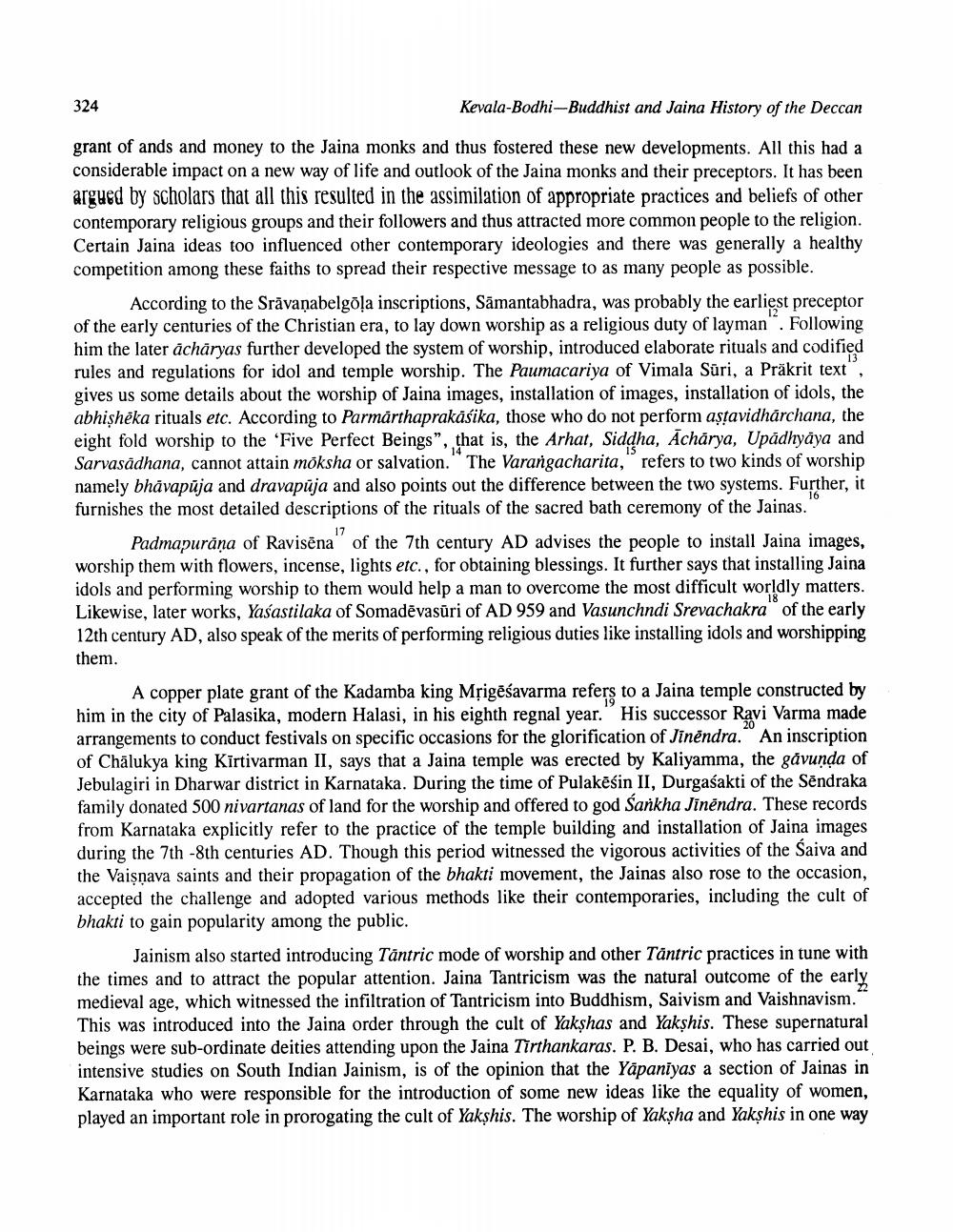________________
324
Kevala-Bodhi-Buddhist and Jaina History of the Deccan
D
.
grant of ands and money to the Jaina monks and thus fostered these new developments. All this had a considerable impact on a new way of life and outlook of the Jaina monks and their preceptors. It has been argued by scholars that all this resulted in the assimilation of appropriate practices and beliefs of other contemporary religious groups and their followers and thus attracted more common people to the religion. Certain Jaina ideas too influenced other contemporary ideologies and there was generally a healthy competition among these faiths to spread their respective message to as many people as possible.
According to the Srāvanabelgoļa inscriptions, Sāmantabhadra, was probably the earliest preceptor of the early centuries of the Christian era, to lay down worship as a religious duty of layman. Following him the later acharyas further developed the system of worship, introduced elaborate rituals and codified rules and regulations for idol and temple worship. The Paumacariya of Vimala Sūri, a Präkrit text", gives us some details about the worship of Jaina images, installation of images, installation of idols, the abhishēka rituals etc. According to Parmarthaprakasika, those who do not perform aştavidhårchana, the eight fold worship to the 'Five Perfect Beings”, that is, the Arhat, Siddha, Acharya, Upadhyāya and Sarvasādhana, cannot attain moksha or salvation. The Varangacharita," refers to two kinds of worship namely bhāvapūja and dravapūja and also points out the difference between the two systems. Further, it furnishes the most detailed descriptions of the rituals of the sacred bath ceremony of the Jainas.
Padmapurāņa of Ravisēna of the 7th century AD advises the people to install Jaina images, worship them with flowers, incense, lights etc., for obtaining blessings. It further says that installing Jaina idols and performing worship to them would help a man to overcome the most difficult worldly matters. Likewise, later works, Yaśastilaka of Somadēvasūri of AD 959 and Vasunchndi Srevachakra of the early 12th century AD, also speak of the merits of performing religious duties like installing idols and worshipping them.
A copper plate grant of the Kadamba king Mrigēśavarma refers to a Jaina temple constructed by him in the city of Palasika, modern Halasi, in his eighth regnal year." His successor Ravi Varma made arrangements to conduct festivals on specific occasions for the glorification of Jinêndra. An inscription of Chālukya king Kirtivarman II, says that a Jaina temple was erected by Kaliyamma, the gávunda of Jebulagiri in Dharwar district in Karnataka. During the time of Pulakēģin II, Durgaśakti of the Sendraka family donated 500 nivartanas of land for the worship and offered to god Sankha Jinēndra. These records from Karnataka explicitly refer to the practice of the temple building and installation of Jaina images during the 7th-8th centuries AD. Though this period witnessed the vigorous activities of the Saiva and the Vaisnava saints and their propagation of the bhakti movement, the Jainas also rose to the occasion, accepted the challenge and adopted various methods like their contemporaries, including the cult of bhakti to gain popularity among the public.
Jainism also started introducing Tântric mode of worship and other Tântric practices in tune with the times and to attract the popular attention. Jaina Tantricism was the natural outcome of the early medieval age, which witnessed the infiltration of Tantricism into Buddhism, Saivism and Vaishnavism. This was introduced into the Jaina order through the cult of Yakshas and Yakshis. These supernatural beings were sub-ordinate deities attending upon the Jaina Tīrthankaras. P. B. Desai, who has carried out intensive studies on South Indian Jainism, is of the opinion that the Yāpaniyas a section of Jainas in Karnataka who were responsible for the introduction of some new ideas like the equality of women, played an important role in prorogating the cult of Yakşhis. The worship of Yaksha and Yakşhis in one way




